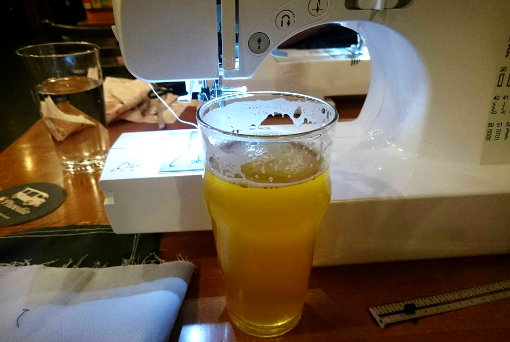Beer 101: Recap
 Last night, I held my first Beer 101 session at Foodie's Marketcafé in Dyer, Indiana. It was a fun and informative evening. The session was an introduction to beer with a focus on standard summer brews. I discussed two of each type: pilsner, wheat, pale ale, and IPA. This way the students could get a good feel for the base of each style, while being able to see the differences the brewers bring to the formula with their unique recipes. The selection was a series of well-rounded brews. The shop is stocking the selection.
Last night, I held my first Beer 101 session at Foodie's Marketcafé in Dyer, Indiana. It was a fun and informative evening. The session was an introduction to beer with a focus on standard summer brews. I discussed two of each type: pilsner, wheat, pale ale, and IPA. This way the students could get a good feel for the base of each style, while being able to see the differences the brewers bring to the formula with their unique recipes. The selection was a series of well-rounded brews. The shop is stocking the selection.- Pilser: Brooklyn & Victory Prima
- Wheat: Upland Wheat & F8 Solar Collector
- Pale: Boulevard & FD Doggie Style
- IPA: NB Ranger & Founders Double Trouble
My goal with the session was to help the students better understand what makes up the beer and why they like/don't like certain beers.
After providing some background on the ingredients and how they impact the final product. I went through each type and discussed the basic make up and the differences that I could pick up on between them. The students were involved, asking really good questions. They talked of past beer experiences, what they've liked and what they'd like to try. With a small group, I was able to talk to each group and answer the specific questions they had about aging, styles, and breweries near and far.
It was a great group. Everyone was interested and attentive. They participated in the discussion. They were actually using this as an experience to find out why they like and don't like certain beers. (Cheers!) It was a diverse group of couples, singles, and friends. Everyone had a different beer background.
I feel that everyone walked out of there knowing at least one fact that they didn't know before the session started.
Popular Fact: Where did IPA get it's name?
For those readers who don't know, IPA is an abbreviation for India Pale Ale. This style is a heavily hopped ale. The ales that the British shipped to the Indian colonies in the 18th century were heavily hopped to preserve it and prevent spoilage during the long voyage. The term is still used to refer to any hoppy ale. Some have even brewed Black IPAs (contradiction in terms).
After providing some background on the ingredients and how they impact the final product. I went through each type and discussed the basic make up and the differences that I could pick up on between them. The students were involved, asking really good questions. They talked of past beer experiences, what they've liked and what they'd like to try. With a small group, I was able to talk to each group and answer the specific questions they had about aging, styles, and breweries near and far.
It was a great group. Everyone was interested and attentive. They participated in the discussion. They were actually using this as an experience to find out why they like and don't like certain beers. (Cheers!) It was a diverse group of couples, singles, and friends. Everyone had a different beer background.
I feel that everyone walked out of there knowing at least one fact that they didn't know before the session started.
Popular Fact: Where did IPA get it's name?
For those readers who don't know, IPA is an abbreviation for India Pale Ale. This style is a heavily hopped ale. The ales that the British shipped to the Indian colonies in the 18th century were heavily hopped to preserve it and prevent spoilage during the long voyage. The term is still used to refer to any hoppy ale. Some have even brewed Black IPAs (contradiction in terms).


What a great idea. I've never heard of this type of course. It'd be great for the skeptics like me.
ReplyDeleteI had one gent who was just there for moral support. He only liked one of the 8 beers. I talked to him for a bit. Even though he didn't find a beer he loved, he learned something in the class. By the end he could tell the differences between the styles and brews. I think it was good learning experience to find out what it's all about. It's getting so much attention these days!
ReplyDelete